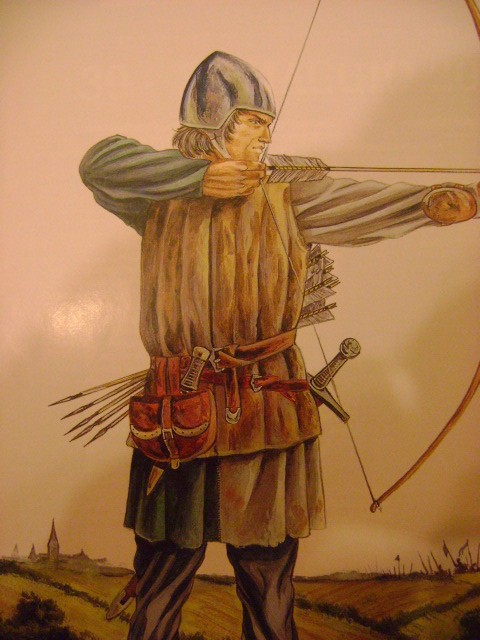 The crossbow played an important role in the late Medieval period. The crossbow was really the first hand-held weapon that could be used by an untrained soldier to injure or kill a knight in plate armour. The most powerful crossbows could penetrate armour and kill at 200 yards.
The crossbow played an important role in the late Medieval period. The crossbow was really the first hand-held weapon that could be used by an untrained soldier to injure or kill a knight in plate armour. The most powerful crossbows could penetrate armour and kill at 200 yards. No bow is perfectly efficient, but Medieval crossbows were particularly inefficient. The reason for this is that the draw length and the lathe (also called a prod) of crossbows are short. So even though a crossbow may have a great deal of stored energy when spanned, the tips of the lathe do not have enough time to reach the maximum velocity, so the amount of stored energy is not transferred fully to the bolt. It is the lathe tip velocity that determines the speed of the bolt th
The French nevEr dveloped their own longbowmen largely for rasons of social contol. Th English longbowmen asserted their rights because they were armed. The French were wary of the under classes being empowered. At Crecy and Poitiers they employed Genoese croSsbowmen mercenaries who posed less of a social threat.
"We few, we happy few, we band of brothers;
For he to-day that sheds his blood with me
Shall be my brother; be he ne'er so vile,
". It is inconcievable for a French knight of the time to consider anyone of the lower class (infantry or archer) as a brother. Their whole society was build on the strongest class distinctions.
At Crecy the French knights rode down their own archers (who shot some of them) because they held them in contempt as mercenaries and non-noble. The English cared for their archers who were valued and respected as much as a commoner could be at the time.
The French at Crecy (and Poitiers) attacked too soon. They merely had to refuse battle for a day or so and the English would have had to move from their pre-pared poasitions. The crossbow string would be dry, the Genoese would have been able to fight on level ground and behind their big Pavises. The pavise was a large shield designed to protect crossbowmen while they reloaded their bows. It was made from wood, boiled leather and canvas and was decorated with coats-of-arms and pictures of saints. Rows of these highly-decorated shields would have been quite an awe-inspiring sight on the battlefield.The pavise
The longbow might loose five times as many arrows per unit of time but grat difference in defensive equipment probably would have given the advantage to the crossbowmen.We'll never know because the French never used the crossbowmen properly at Crecy (or Poitiers). After all the French went into battle even before their own large infantry had arrived. They threw away all their advantages. If the battle had started with a real duel between crossbowmen and longbowmen where the crossbowmen weren't crippled by the stupidity of the French knights they might still have lsot but they would have thinned the ranks of the longbowmen and that might have been enough. The Hundred Year's War would have been over almost at the beginning.As it was the Fench learned nothing and repeated all their mistakes again and again at Poitiers and Agincourt.at is loosed.
A lthough there are working examples of Medieval crossbows, there are no working examples of Medieval longbows, so a direct comparison between the two cannot be made. Hence, the only data I can draw on for longbows is either from historical evidence or from reproductions of Medieval longbows. It is my belief that while the range of longbows changed very little from the 11th. century through Medieval times, the range of crossbows certainly did increase. Historical evidence would indicate that in the hands of a well-trained longbowmen, distances of 250-350 yards were commonly attained. A few modern archers have regularly achieved distances of 350-450 yards with reproduction longbows. Inigo Simot loosed an arrow 462 yards 9 inches in 1914, and there is a claim of someone loosing an arrow 482 yards with a longbow.
At the time of the battle of Crecy (1346 C.E.), the English longbow almost certainly had a greater range than the crossbow used in field combat.
With range out of the way, power is an even more difficult subject to breach. In general, arrows weigh more than bolts, so they have a larger momentum (force) associated with them. However, a late Medieval crossbow bolt has a higher speed associated with it, which will overcome the lower mass. (the the force being equal to the mass times the square of the velocity).

No comments:
Post a Comment